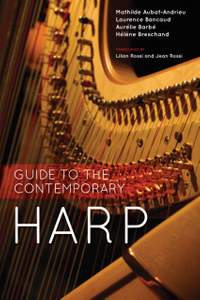Guide to the Contemporary Harp
- Author: Aubat-Andrieu, Mathilde
- Author: Bancaud, Laurence
- Author: Barbe, Aurelie
- Author: Breschand, Hélène
- Translator: Rossi, Jean
- Translator: Rossi, Lilian
Book
$94.00Contents
- Preface
- Acknowledgements
- Introduction
- 1. Organology
- I. Historical Reminders
- II. The Pedal Harp
- General Characteristics
- The Parts of the Harp
- The Strings
- The Pedals and the Modulation Mechanism
- "Using the Pedals"
- Pedal Notation
- Playing the Harp
- III. The Lever Harp
- General Characteristics
- The Strings
- Levers and the Modulation Mechanism
- Playing the Lever Harp
- IV. Electric Harps
- The Electroacoustic Harp
- The Electric Harp
- The Electric-Acoustic Harp
- V. Some 21st Century Creations
- The MIDI Harp
- The Automatic Harp
- 2. Writing and Language
- I. Notations
- Measured Notation
- Unmeasured Notation
- Proportional Notation
- Introduction of the Aleatory Element (Indeterminacy)
- Open Works
- Combination of Several Notations
- Superposition of Different Tempi
- Writing on Several Staves
- Writing with Another System than the Five-Line Stave
- Graphic Scores
- II. Dramatized Writings
- Micro-Choreography, Theatrical Gestures
- Dramaturgic Use of the Voice
- Use of the Sung Voice, with No Theatrical Indication
- Use of the Spoken and/or the Sung Voice with No Text
- III. Mixed Forms of Music
- Some Works for Harp and Extensions
- 3. Playing Techniques
- I. Timbre
- "Pres de la table" (Near the Soundboard)
- "Bas dans les cordes" (Low in the Strings)
- "Pres des chevilles" (Near the Tuning Pins)
- Harmonic Sound
- Sound Using the Fingernail
- Koto Sound
- Plucked Sound
- Vibrated Sound
- Portando From One Pitch to Another
- Xylo Sound
- Pizzicato (Pizz.)
- Bartok Pizzicato
- Normal Position
- Bisbigliando
- Tone-Color Melody (Klangfarbenmelodie)
- II. Glissandi, Chords and Clusters
- Single Glissando
- Fast Glissando
- Multiple Glissando
- Pitchless Glissandi
- Flat, Broken, Arpeggiated/Rolled Chords
- Cluster Glissando
- Rasgueado
- Cluster Glissando with Thunder Effect
- Cluster
- Muffled Cluster
- Tremolo Cluster
- Aeolian Cluster
- Various Forms of Rubbing
- III. Resonances, muffles and silences
- Muffles
- Let Vibrate
- Fermata
- IV. Hits on the harp
- Different Types of Hits
- Which Part of the Harp to Hit?
- Composers Who Have Elaborated a Detailed Notation for Hits
- V. Wire strings
- Whistling Sound (with the Palm of the Hand)
- Wired Sound (Grabbing a Wire String with the fingers)
- Scrape with a Nail or a Plectrum
- Buzz
- Thunder Effect
- Sustained Thunder Effect
- VI. Pedals and Levers
- Pedal Glissando
- Pedal Trill
- Rhythmic Effect with Pedals
- Pedal Movement Ad Libitum with Sound Effect
- Pedal Buzz
- Resonant Pedal Sound
- Levers
- Thunder Effect
- VII. Using Objects
- Metal Rod
- Stick
- Use of Percussion Instruments by the Harpist
- Bow
- Electronic Bow
- Plectrum
- Other Objects
- Prepared Harp
- Inserting Materials Between the Strings (Foam, Paper, Cardboard, Textile, Rubber, Elastic Band, etc.)
- VIII. Scordatura
- Pedal Harp
- Lever Harp
- Two Harps
- Conclusion
- Significant Landmarks
- List of Notations
- Bibliography
- The History of Music in the 20th and 21st Centuries
- Contemporary Notation
- Musical Instruments, The Orchestra
- The Harp
- Internet Sites
- Repertoire of Works for Harp
- Solo Harp
- Harp and Extensions
- Lever Harp
- Lever Harp and Extensions
- Duets and Harp Ensembles
- Concertos
- Duets
- Trios
- Quartets and More
- Ensembles and Extensions
- Index of Composers Quoted
- Index of Playing Techniques




